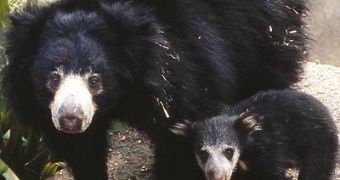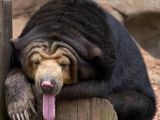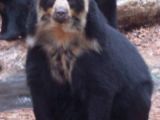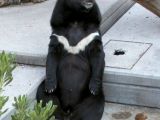There are 8 living species of bears. Bears split of raccoons and bear-dogs about 35 MA ago. The first bears were small, resembling the dogs. Panda bear was the first bear to diverge from the branch that led to the other bears. The bamboo diet turned them big. Millions of years later, the ancestor of the other bears appeared in southern Asia.
10-12 MA ago, the running bears appeared. They had longer limbs than the modern bears, lived in open spaces and could hunt rapid animals. About 8 MA ago, they passed from Asia to North America and today their only surviving species is the speckled bear. The largest species of Carnivora to have ever existed is a fossil running bear that lived in North America 800,000 to 12,500 years ago: the Short-Faced Bear (Arctodus).
Ursus minimus, which lived 5 MA ago in Asia, gave birth to both the American and Asian black bears and Ursus etruscus. Ursus etruscus evolved into Ursus savini 1 MA ago. In Asia, Ursus savini formed the brown (grizzly) bear, while in Europe it formed the cave bear (Ursus spalaeus). The polar bear evolved from a population of brown bear in the Behring area, no earlier than 500,000 years ago, and it started to use ice as a platform for hunting seals.
Like humans, bears walk on the whole sole of the foot (they are plantigrade). They can adopt a bipedal position when looking for dangers, food or fighting.
All bears can swim; of course, the best swimmer is the polar bear, which is almost a marine mammal.
The bear olfaction is as fine as that of the dogs. The hearing is keen, too. It is not known if bears can distinguish colors, but they make the difference between ripe and unripe fruits. Most bears have extensible lips, not attached to their gums. Some bears can pick up and even skin fruits with the lips.
Bears have non-retractile claws that can be up to 15 cm (6 in) long. Bears are amongst the carnivorous mammals with the largest number of teeth and many species are adapted to plant diet.
When hunting, brown bears, despite their huge size, can reach 50 km (31 mi) per hour. Moreover, bears have a high stamina. Generally, bears are opportunistic, eating anything, including human wastes or beached whales. Even the polar bears, the most carnivorous species of bear, eat grass when prey is not available. Still, each bear species has a base diet.
The speckled bear (Tremarctos ornatus) of the Andes eats 80 % plant matters. Its favorite food items are bromeliaceae plants (related to pineapple) that grow up into the trees, as epiphytes. The bears must climb the trees and bring down the plants for feeding on them.
The favored food of the Indian sloth bear (Melursus ursinus) is made of termites. After finding a termite nest, the bear uses its extensible lips to absorb noisy the insects, while closing its nostrils. Because of this type of feeding, this bear lacks its upper incisor teeth.
The American black bear (Ursus americanus) eats mainly fruits and insects, and occasionally meat.
The Sun bear (Helarctos malayanus) of southeast Asia is the smallest bear and feeds on insects and fruits, but it is also a great amateur of honey. This bear has the longest tongue of all.
The Asian black bear (Ursus thibetanus) is a very good climber and eat almost anything, while the Panda bear (Ailuropoda melanoleuca) has a diet made almost exclusively of bamboo. The extinct cave bear of the European Ice Age was mainly vegetarian.
Polar bear can hibernate 4-6 months annually, while tropical bears do not hibernate at all.

 14 DAY TRIAL //
14 DAY TRIAL // 


